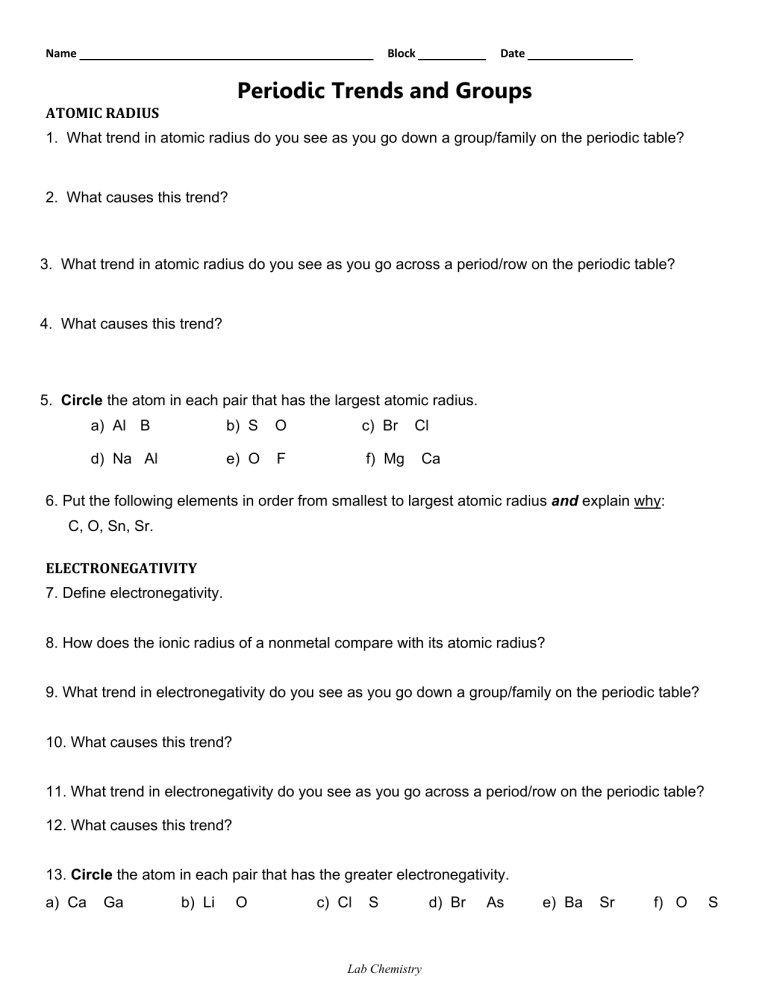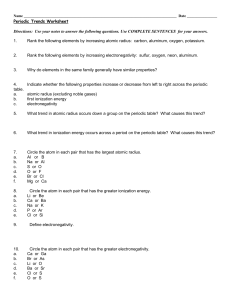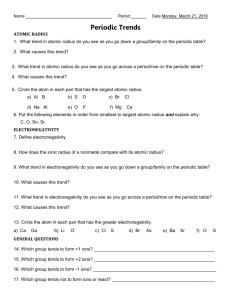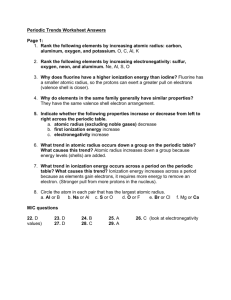d9dc7af46d9bd52d15637f218770d17d content-type=application%2Fpdf&content-disposition=attachment%3B%2Bfilename%3D%22WS Periodic Trends and Groups.pdf%22&Expires=1623628515&Signature=dEAX6KAY0Thov iL2hnUxtK RuTgHd-mm6
advertisement

Name Block Date Periodic Trends and Groups ATOMIC RADIUS 1. What trend in atomic radius do you see as you go down a group/family on the periodic table? 2. What causes this trend? 3. What trend in atomic radius do you see as you go across a period/row on the periodic table? 4. What causes this trend? 5. Circle the atom in each pair that has the largest atomic radius. a) Al B b) S O c) Br d) Na Al e) O F f) Mg Cl Ca 6. Put the following elements in order from smallest to largest atomic radius and explain why: C, O, Sn, Sr. ELECTRONEGATIVITY 7. Define electronegativity. 8. How does the ionic radius of a nonmetal compare with its atomic radius? 9. What trend in electronegativity do you see as you go down a group/family on the periodic table? 10. What causes this trend? 11. What trend in electronegativity do you see as you go across a period/row on the periodic table? 12. What causes this trend? 13. Circle the atom in each pair that has the greater electronegativity. a) Ca Ga b) Li O c) Cl S Lab Chemistry d) Br As e) Ba Sr f) O S GENERAL QUESTIONS 14. Which group tends to form +1 ions? ________________________________________________ 15. Which group tends to form +2 ions? ________________________________________________ 16. Which group tends to form -1 ions? _________________________________________________ 17. Which group tends not to form ions or react? _________________________________________ 18. Based on the concept of periodic trends, answer the following questions for these atoms: Li, Be, Mg, Na. Be able to defend your answers. a. Which element has the lowest electronegativity? _________________________________ b. Which element has the least metallic character? _________________________________ c. Which element is the largest atom? ___________________________________________ 19. Based on the concept of periodic trends, answer the following questions for these atoms: P, S, Cl, F. Be able to defend your answers. d. Which element has the highest electronegativity? ________________________________ e. Which element has the least metallic character? _________________________________ f. Which element has the largest ion? ___________________________________________ 20. Based on the concept of periodic trends, answer the following questions for these atoms: Au, Zn, S, Si. Be able to defend your answers. a. Which element has the highest electronegativity? ________________________________ b. Which element has the most metallic character? _________________________________ c. Which element has the largest atom? _________________________________________ Lab Chemistry 21. Complete the following chart: Example: K Mg Ne N Cl Si Atomic # Period Group # Group/ Family name (if any) # of valence e# of protons Metal, nonmetal, or metalloid? Conducts electricity? (yes/no) Phase/State at room temperature? Ion Formed? (positive, negative, none, varies) 22. _____________ metal a. alkaline earth metals 23. _____________ chlorine b. metals with unpredictable properties 24. _____________ metalloid c. a halogen 25. _____________ transition elements d. make good semiconductors 26. _____________ group 1 e. alkali metals 27. _____________ noble gases f. 28. _____________ group 2 g. loses electrons in bonding Lab Chemistry has a full outer energy level (shell) Instructions Fill in the arrows below with the following terms: increasing electronegativity, increasing metallic character, increasing atomic radius, increasing nonmetallic character, & increasing ionization energy. (There can be multiple terms per arrow.) Lab Chemistry


